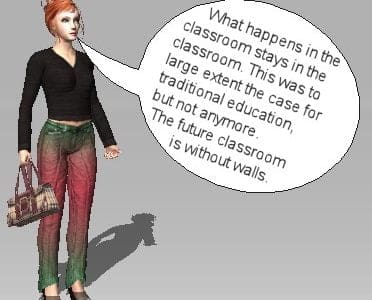 The third part of this series of articles takes off in trying
The third part of this series of articles takes off in trying![]() to answer how meaningful the trend-reconnaissance in the Horizon Report Europe 2014 Schools Edition really is. In the meaning how these trends that are described in the report could be put in practice in an educational environment.
to answer how meaningful the trend-reconnaissance in the Horizon Report Europe 2014 Schools Edition really is. In the meaning how these trends that are described in the report could be put in practice in an educational environment.
Why will these trends get foothold?
The short answer is that the development of technology now has reached as far as it de facto creates a profound improvement of learning. For instance when it comes to user-friendliness, adaptability and content that in its interactive form creates added value to learning and teaching. In addition other parts of society are ahead of the school’s development when it comes to digitalization. These “other parts of society” that the school should prepare its students for.
ADVERTISING:
[adrotate group=”3″]
How can these trends be managed in practice?
What happens in the classroom stays in the classroom. This was to large extent the case for traditional education, but not anymore. The flipped classroom, which is using a reverse pedagogy in comparison with the traditional, is an important part in this transformation that e.g. means that:
- From have used most parts of the classroom-time for introduction in front of the blackboard to record the introductions for homework, which also produce better help for parents and others that are helping with the homework.
- Instead the classroom-time is used for one-to-one teaching and project-based teaching in order to put the educational material in a more reality-based context.
- Other developments from the report that help integrating education in a more reality-based environment is the use of laboratories as well as virtual labs as well as other forms of simulations will be increasingly more common in the class-work during the years to come.
- Beyond that the flipped classroom contributes to improvements for help with homework that was mentioned above. The prospects to directly involve parents and others in the student’s educational development improve dramatically with the learning-platform’s activity- and analysis-system.
From these prerequisites the new study-environment thereby will become increasingly more collaborative with more direct connection to the real world. But at the same time the learning will become more individualised with many different forms of learning, individual-adapted teaching, better prerequisites for self-studies. The achievement is motivation, engagement, adaptability in a more entrepreneurial environment. The future classroom thereby is a collaborative platform with several interactive tools and for many different meeting-forms. This in contradiction to the 2000th Century’s classroom walls that in comparison could be described as a shelter from which the students at best take with them some small boxes of limited knowledge-doses in different subjects. In the fourth part of this series of articles we will dig deeper to what will be waiting for a student and her learning environment in a digitalized school.
Written by
LarsGöran Boström©
Opens in a new tab



